This easy-to-make recipe for homemade yamagobo is so fun & quick. The delicious Japanese pickled root is crisp, briny, sweet, and colorful. It goes well with sushi, stir-fries, & all your favorite Asian dishes, so make a lot so it is always ready in your refrigerator.
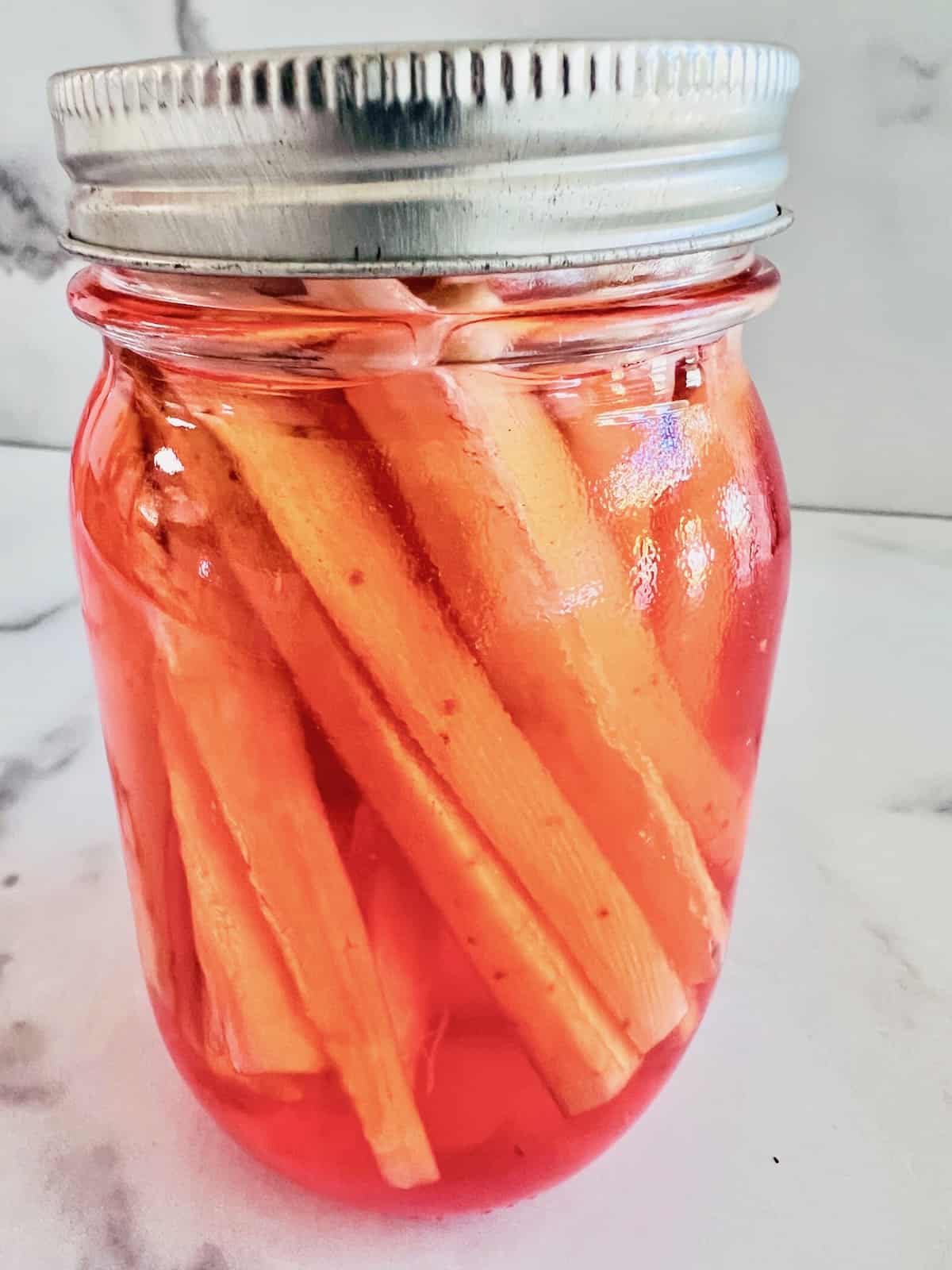
These fast pickles will be something you will crave all the time. Pickled vegetables are a great low-calorie way to add a ton of flavor & crunch to any meal. Like my Korean Pickled Vegetables, this Asian-inspired condiment is amazing.
These crisp salty bites are great for snacking, adding to recipes, or making homemade vegan sushi rolls. I enjoy serving yamagobo along with my Spicy Salmon Poke Bowl or as a condiment with Teriyaki Chicken Skewers. Convinced yet that you need to make this recipe?
Jump to:
What is Yamagobo?
Yamagobo is a pickled root vegetable that makes a great condiment or addition to meals. It is made by pickling burdock root in rice vinegar, salt, & sugar. The Japanese word or meaning for burdock is gobo. The briney version is yamagobo.
It is common in Asian dishes & is believed to have medicinal properties. People who are allergic to burdock, pregnant/plan to be pregnant, under 18, or have any of these issues, should NOT drink burdock tea and keep it to a minimum. Please check with your physician before consuming yamagobo.
What Does Burdock Root Taste Like? That is probably what you are now wondering. Before it is pickled, gobo doesn't have much flavor with a slight earthy taste. I would describe it as drier less flavorful jicama.
But once it is processed into a pickle - wow! It’s tangy, salty, tart, and a little bit sweet. The refreshing crunchy texture, acidic kick, and bright orange color add so much to any dish, sushi, or recipe.
Where to Buy Burdock Root?
To make yamagobo, you will need the key ingredient, burdock root. This long slender root is likely not found in your regular mainstream grocery store. If you don't know what it looks like, burdock root has dark brown skin that is slightly fuzzy with thin roots & a knobby look.
The best places to find burdock root are at farmer's markets, Asian grocery stores, or a Japanese market. Ask or call around to find it near you.
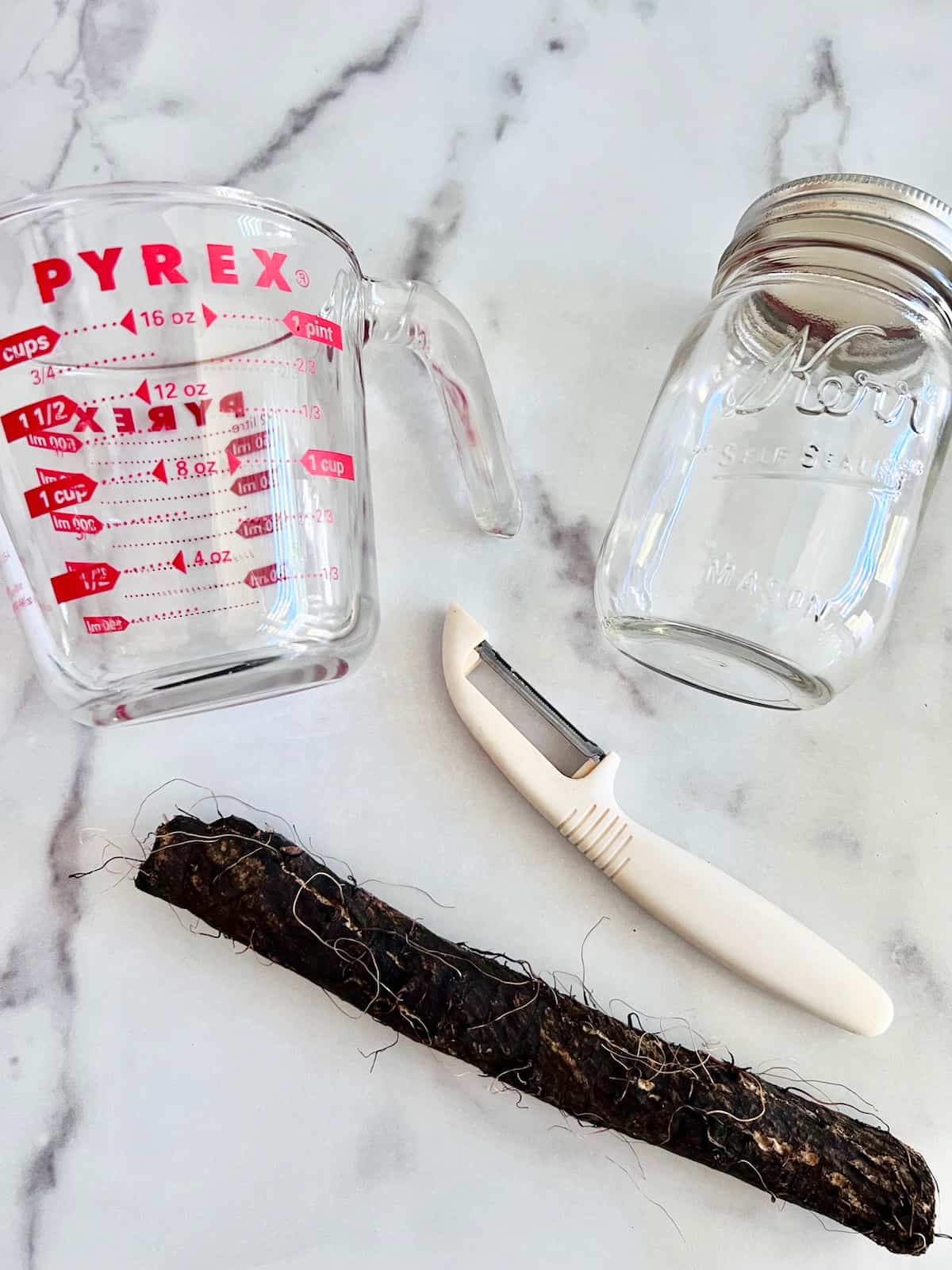
Burdock root is very inexpensive. I highly recommend making this at home since it is so easy to make. Plus buying it already made at a store or yamagobo online, is quite pricey. All you need is these few pieces of kitchen equipment plus a quality chef's knife & you are ready to go.
Recipe Video
Ingredients for Yamagobo
All you need to make yamagobo at home is 5 ingredients plus some water. Once you find the burdock root locally, the rest of the items are already likely in your pantry.

- Burdock Root - the Japanese root is the star of the recipe.
- Rice Vinegar - the acid helps pickle the root & I like to use sodium-free & sugar-free rice vinegar since it's added later & to control the levels
- Salt - to make the pickling brine
- Sugar - for sweetness & preservation
- Orange Food Coloring - optional but highly recommended to give it that gorgeous bright color
- Water
See the recipe card for quantities.
How to Cut Burdock Root
To ensure the pickles fit into the jar you will be using for the pickling process, make sure you are preparing the burdock root correctly. Here are the steps for the best way to peel and cut burdock root when making pickles.
Begin by using a vegetable peeler to remove the tough bark-line skin from the burdock root. Make sure it is all removed but it ok to see the black polka dots in the white root below that exterior.

For this recipe, I am using a 16oz Mason Jar. It is just the right size for the amount of liquid & the burdock root.
To ensure the root is the right size for the jar, hold up the peeled piece of burdock next to the jar as shown below. Then you will want to make cuts along it so that the root will fit into the jar and be submerged under the pickling liquid at all times.
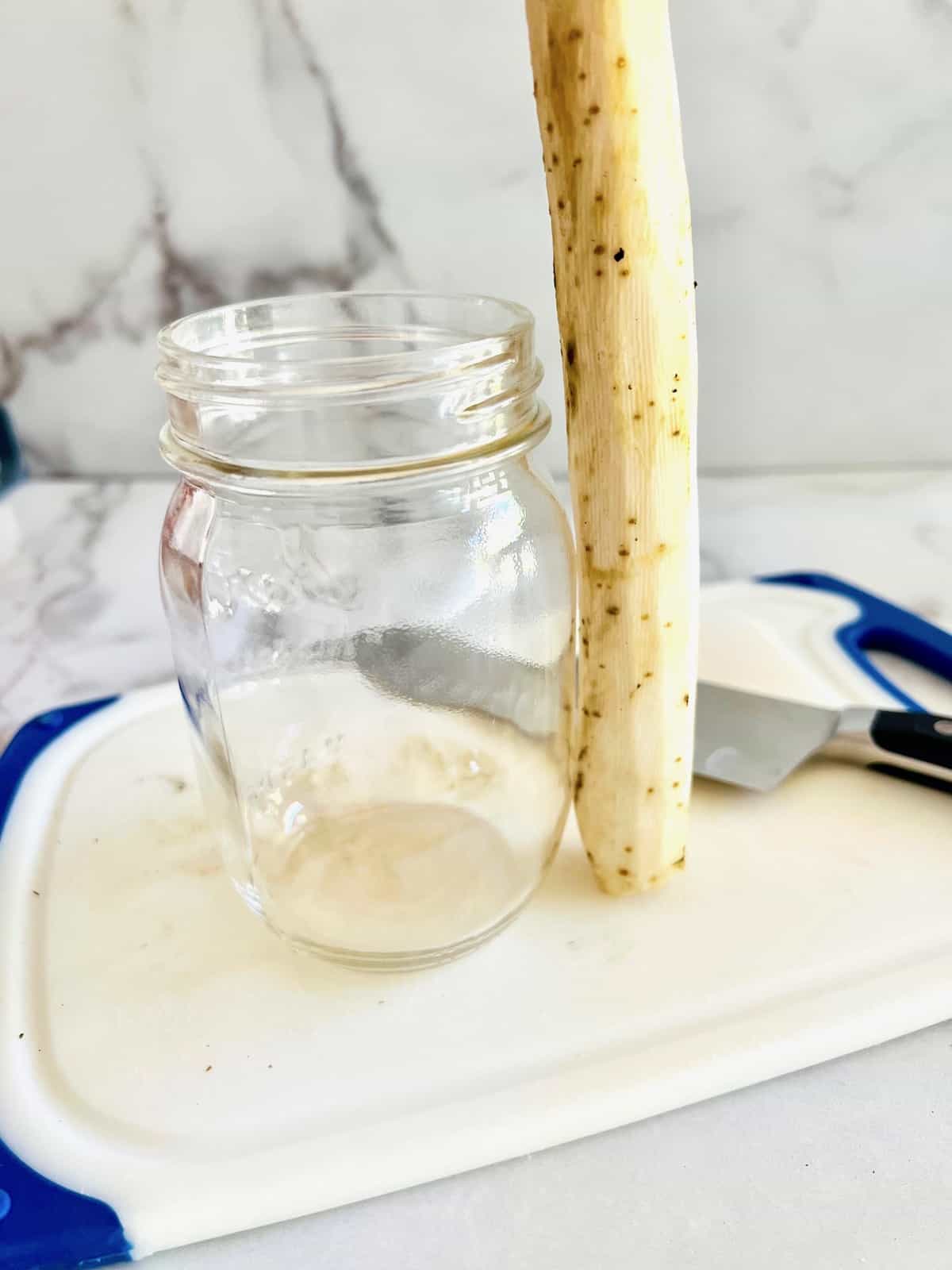
Once you cut the root into 2-4 pieces, make sure they are the same size as the jar you will be using. Line them up next to one another to be sure. Trim off any pieces that will be too big to fit.
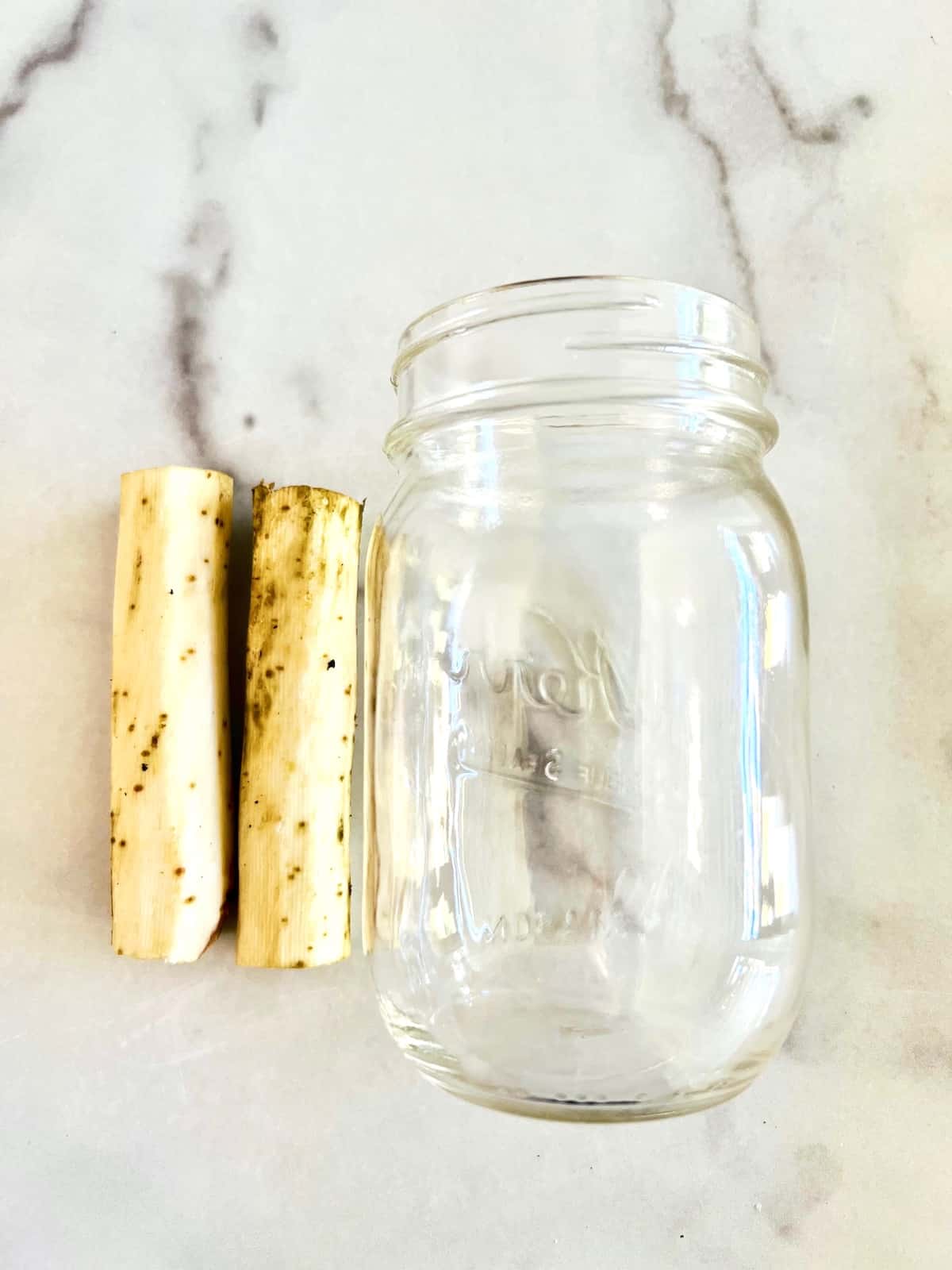
Using your sharp chef's knife, begin cutting the root into thin stalks as shown below. I cut each piece into 8 thinner long pieces. From my one medium-sized root, I ended up getting 16 pieces - how many you may get will vary.
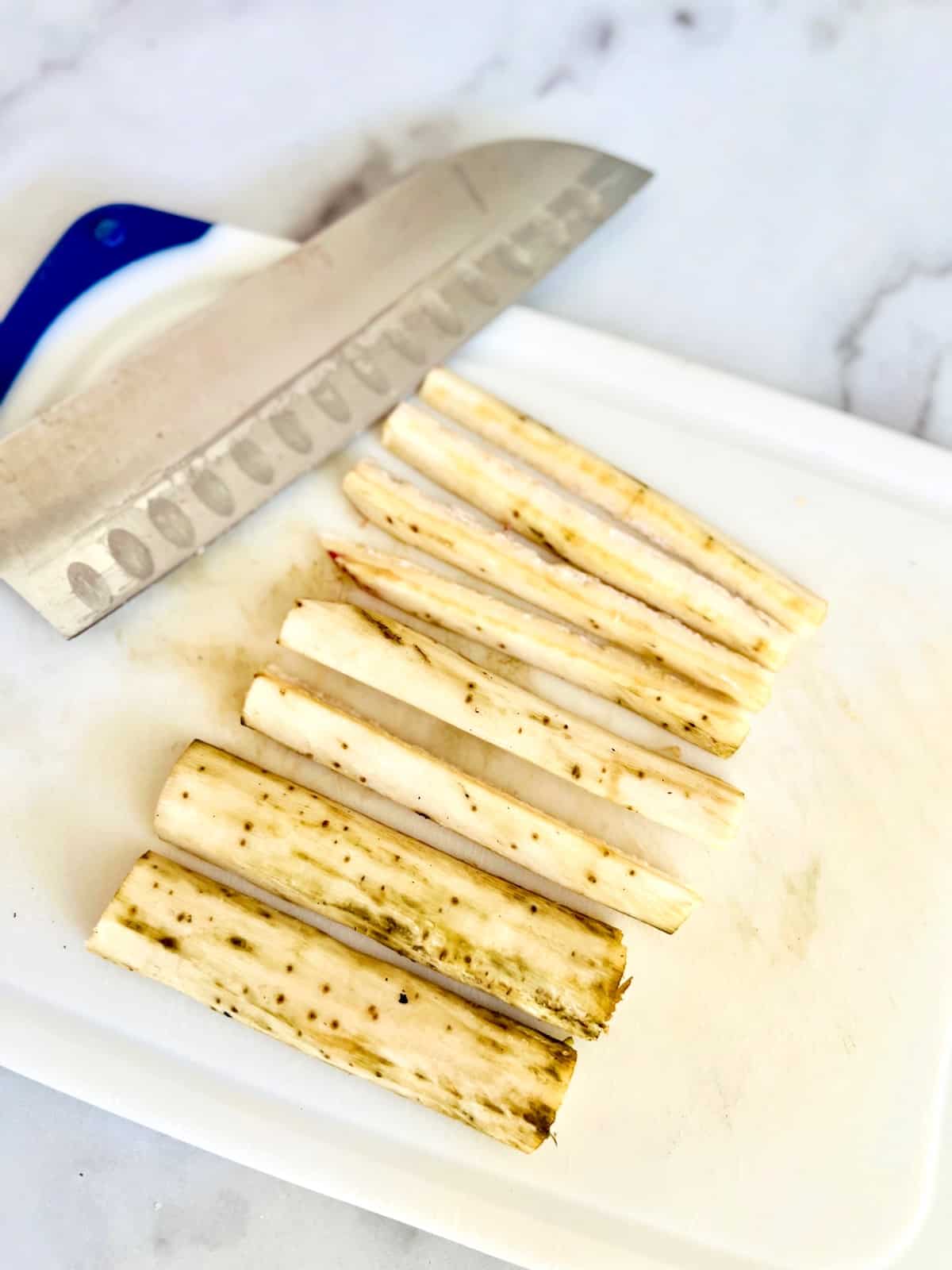
How to Make Yamagobo
Now that the root is cut into pieces, it is time to make the pickling liquid. I do this quickly in the microwave with these easy steps.
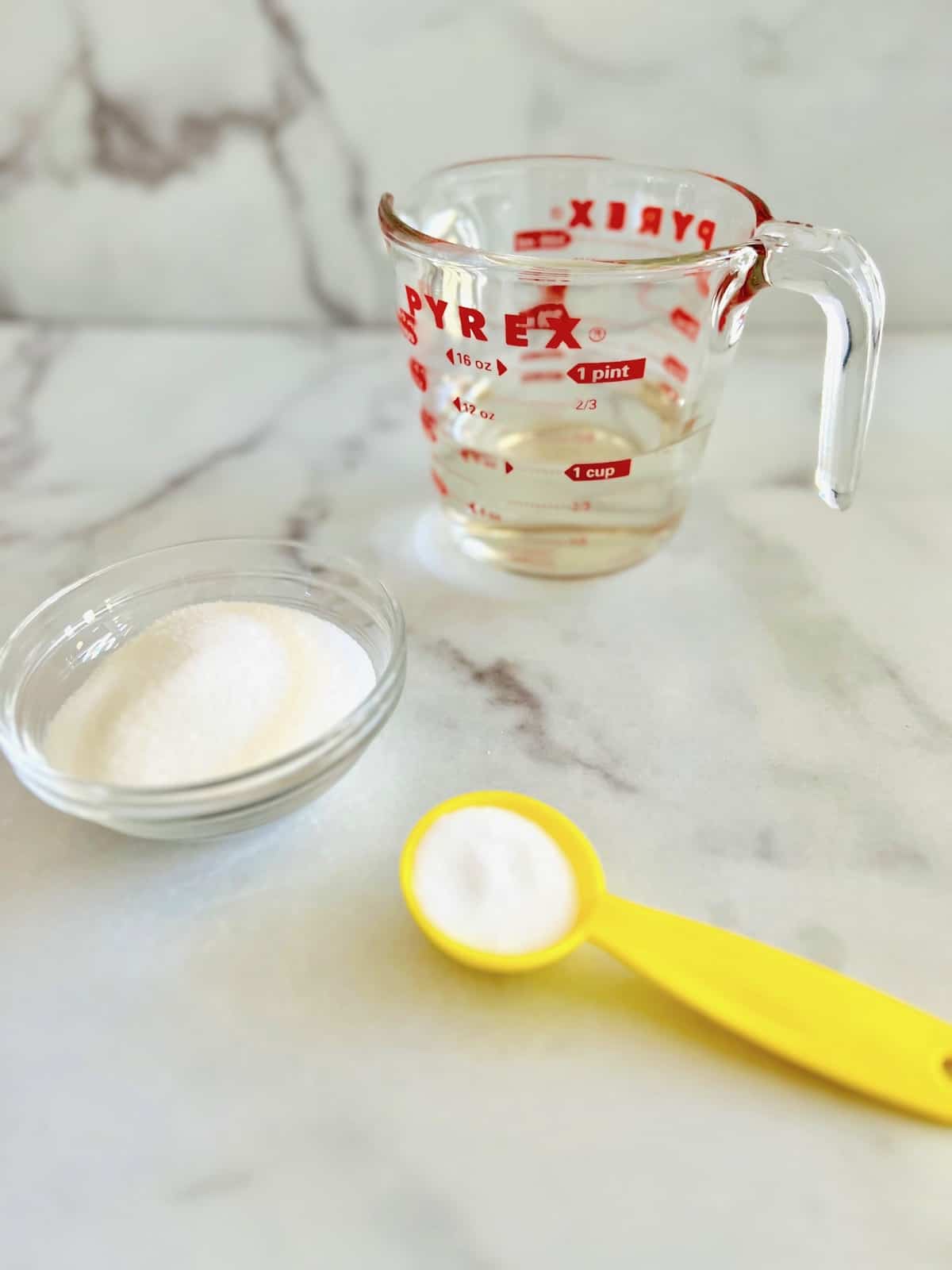
In a microwave-safe measuring cup (or pourable bowl) add the rice vinegar, salt, sugar, & water. Stir to combine.
Microwave for 2 minutes so that the liquid is boiling. Stir to make sure the sugar and salt are completely dissolved. Finally, add the orange food coloring and stir.

Now add the stalks of burdock root to the mason jar. Slowly add the liquid to the mason jar. It should cover the root and not overflow the jar.
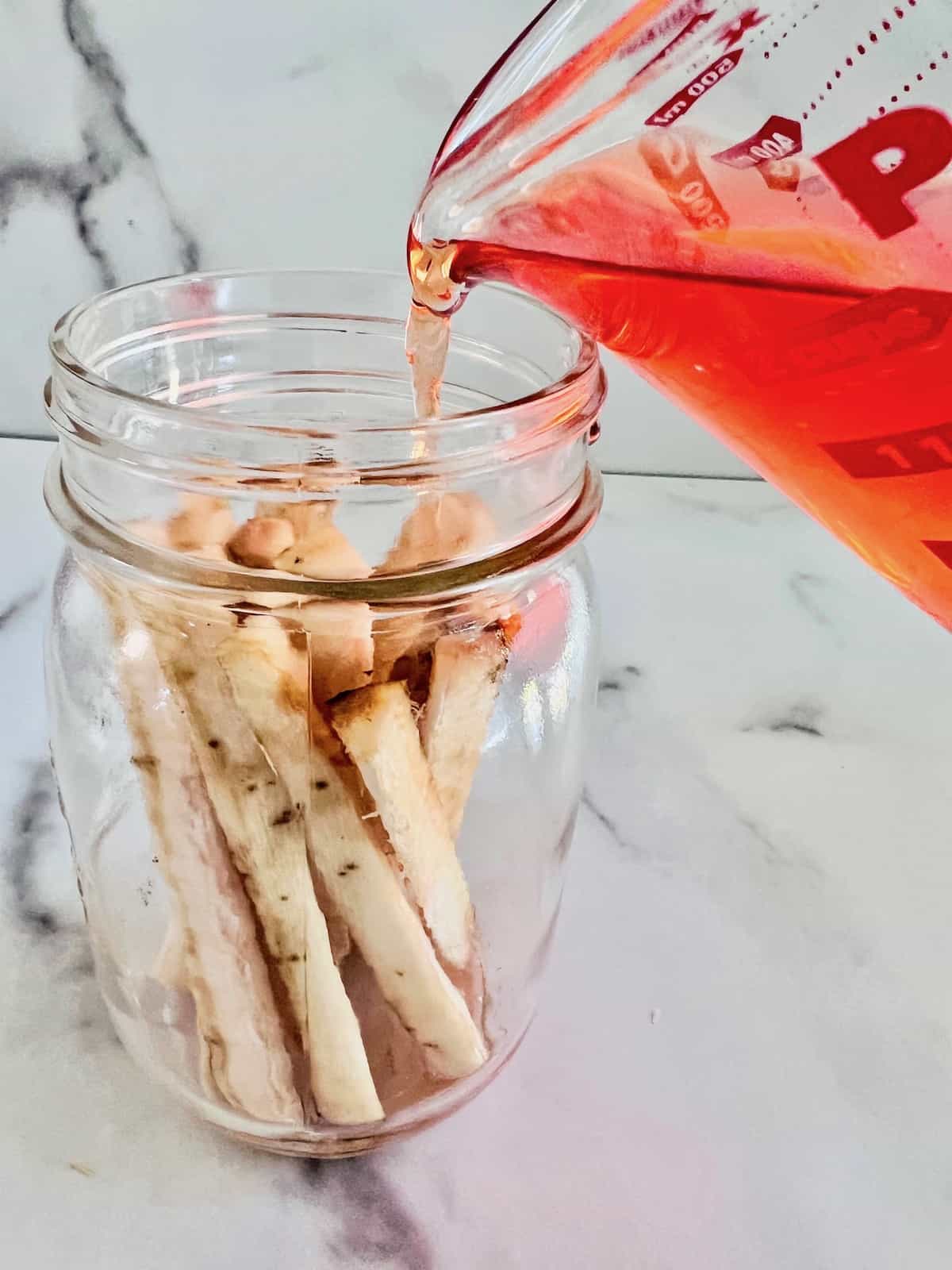
Let the liquid cool before screwing on the top. CAUTION: DO NOT screw the top on while the liquid is still HOT - the glass may explode, break, or crack due to the pressure the heat will create.
Place the jar in the refrigerator for it to work its magic. It needs to marinate for several days before they are ready to eat.
Hint: if the burdock root keeps floating to the top and is not submerged in the liquid it is likely one of 2 things - there is more space in the jar than there is root (often when using a smaller piece) or they are cut too tall and poking above the liquid line. They won't go bad but you may want to rotate them so that the tops get submerged the following day.
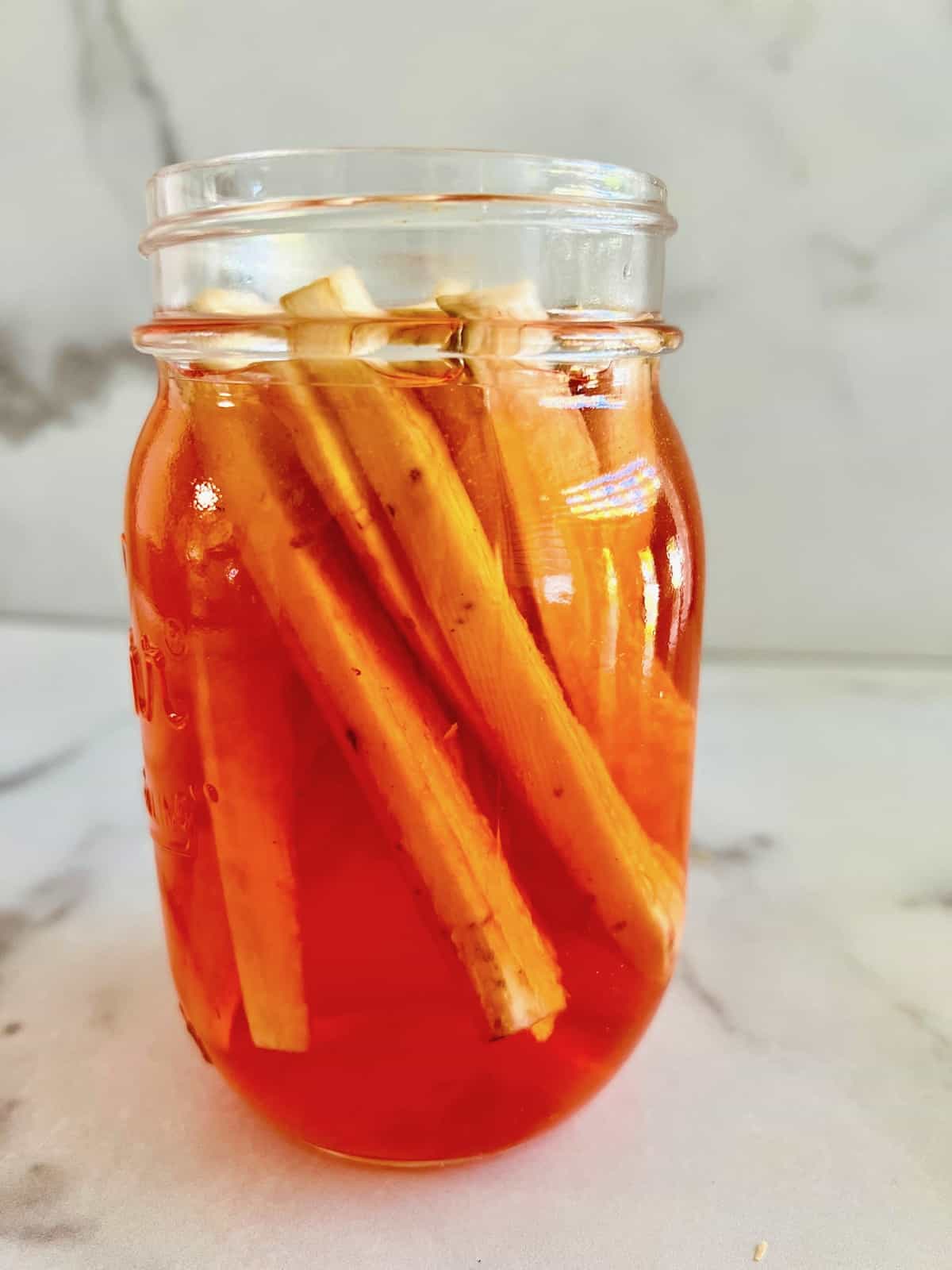
When is Yamagobo Ready to Eat?
This is a quick pickling recipe. Similar to my recipe for making hoemamde pickles using leftover pickle brine, yamagobo will be ready in just 1-3 days. (depending on how thick or thin you make your stalks) They are ready to munch on once they are a bit soft with a bit of crunch still. When you eat one it should have a pleasant sweet & salty briny flavor.
Substitutions
Yamagobo is already vegan, vegetarian, gluten-free, & low-fat. Here are a few alternate ways to make yamagobo using substitutions for the ingredients shared in this recipe.
- Rice Vinegar - use ume (plum) vinegar instead; also can be found in Asian or Japanese markets or apple cider vinegar which is easy to find
- Baby Burdock Root - if you find a thin slender baby burdock root, no need to slice it, just peel it and add stocks that fit into the jar.
- Orange Food Coloring - as a substitute use equal parts red & yellow (1 drop each)
If you wish to have a spicy pickle, add thinly shaved garlic & some red pepper flakes to the pickling liquid.
What to Eat or Serve with Yamagobo
Here are some great pairings that go well with this pickled condiment. The best way to use yamagobo is in gobo sushi. It's easy to make at home just make sure you make enough sushi per person.
These are the top ways to enjoy eating yamagobo as an accompaniment or side and what to serve it with.
- Gobo Rolls - make homemade sushi at home with nori, sushi rice, & sticks of yamagobo in the center for a vegan sushi roll.
- Poke Bowls - instead of pickled ginger add this to a poke bowl
- Rice Bowls - using a grater, shred yamagobo over any rice bowl with protein & sauteed veggies
- Ramen - add to your favorite bowl of noodle soup
Here are some great ideas for what to pair with this yamagobo recipe:
Equipment
The right ingredients, supplies, & equipment help recipes taste amazing & turn out well. Here are recommendations for products that are needed for making this recipe. Shop this recipe & buy these top-rated items today.
The Short Order Cook participates in the Amazon Services LLC Associates Program. As an Amazon Associate, I earn from qualifying purchases. If you click on a link and make a purchase, I may earn a small commission on the sale at no additional cost to you. This helps with the costs of running the blog. Thank you!
Storage
This pickled root stores well in the refrigerator for up 6 months. They store well for up to 6 months if stored properly and remain unopened. If you have opened the jar to eat some, make sure the lid is on tight again and they can last for up to 30 days.
To ensure yamagobo stays fresh, the root should be submerged in the brine at all times. Dry stalks may spoil after a week or so.
I do not recommend freezing jars of homemade yamagobo. The liquid will expand and break the glass which is unsafe.
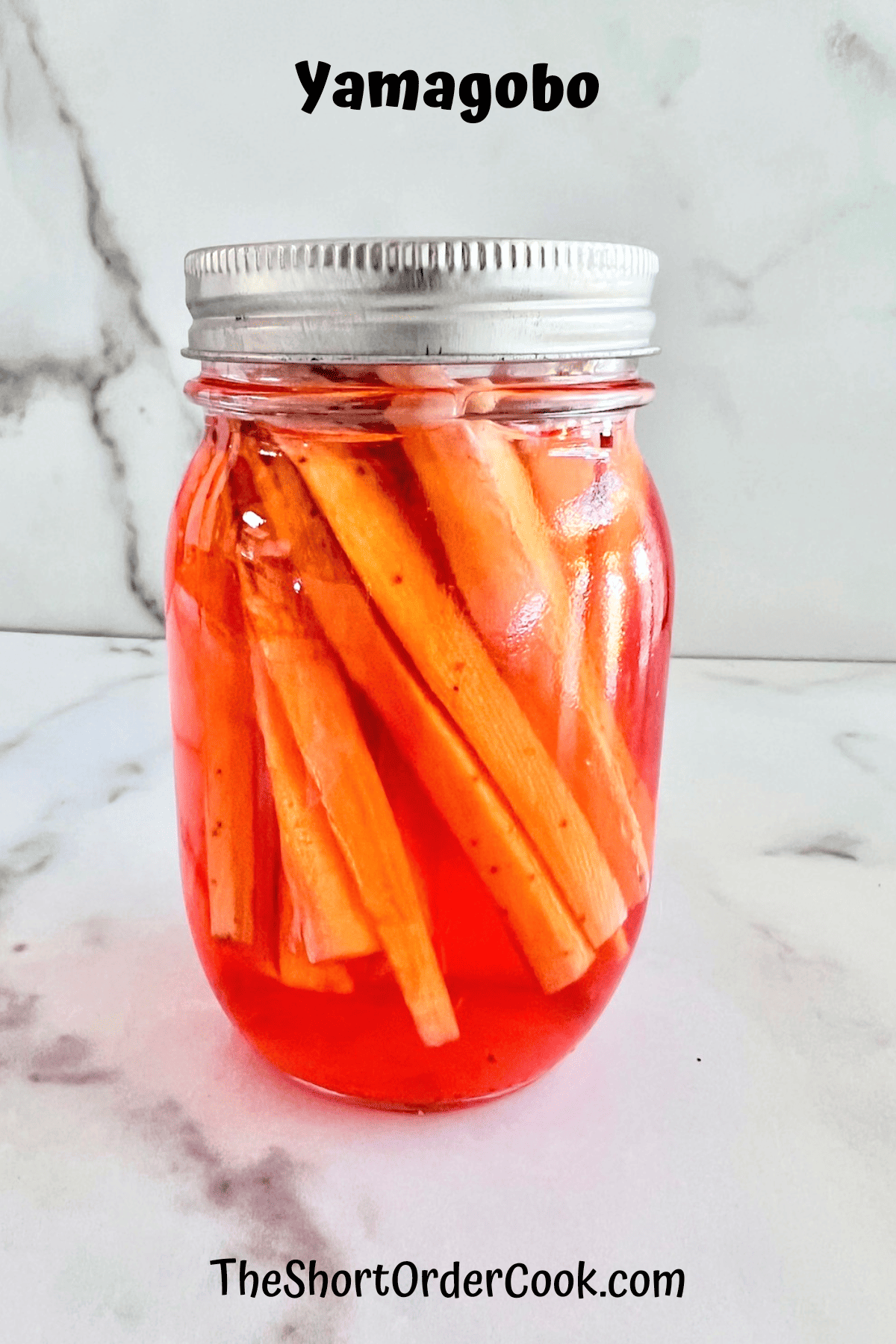
Top Tips
All of these great tips are shared in the post. But these are so good and important they are worth mentioning again so you don't miss them.
- Find burdock root in Asian grocery stores, Japanese markets, or farmer's markets.
- Make sure the roots are cut to fit into the mason jar you will be using.
- Combine red & yellow food coloring if you don't have orange
- Rotate the roots if they are not staying submerges so both ends pickle evenly.
- Do NOT place the lid on the jar until the liquid is cool - it may break or crack if sealed with hot liquid.
- Use it to make sushi or add to your favorite ramen, poke, or Japanese dishes.
FAQ
Any fermented or pickled vegetables have great gut health benefits. Burdock root itself has health benefits too. It acts as a diuretic & helps with inflammation to start.
True yamagobo should be made only with burdock root. But if you cannot find any & want to enjoy a Japanese pickled vegetable for sushi or meals, here are other items you can try; carrots, daikon, jicama, or radish. All will have a similar crunchy texture and will absorb the liquid & taste pickled.
This root has been enjoyed for centuries, mostly for the health benefits shared above. It has been enjoyed steeped in hot water. Burdock tea is the most popular way to enjoy this Japanese root. It is enjoyed shredded or shaved raw in a salad. It is also great to cut into small matchsticks or fine dice and added to stir-fries.
The bright orange food coloring traditionally used when pickling burdock root can make it appear to be a carrot. But yamagobo is not a carrot. Though carrots are a root vegetable and burdock is a root, both do grow underground.


Yamagobo
Equipment
- Mason Jar
- Vegetable Peeler
Ingredients
- ½ pound burdock root
- ⅓ cup rice vinegar
- ½ cup water
- ½ cup granulated white sugar
- 1 tablespoon salt
- 2 drops orange food coloring optional but HIGHLY recommended
Instructions
- Peel the gobo and then cut it into stalks the same size as the mason jar you will be using. Line them up next to one another to ensure the root will fit once the liquid is added & the lid is closed. (see images above)
- Next, use a sharp chef's knife to cut the burdock root into evenly-sized matchsticks. I got 8 thin cuts out of each round stalk chunk (again see images above)
- In a microwave-safe measuring cup (or pourable bowl) add the rice vinegar, salt, sugar, & water. Stir to combine.Microwave for 2 minutes so that the liquid is boiling. Stir to make sure the sugar and salt are completely dissolved. Finally, add the orange food coloring and stir.
- Now add the stalks of burdock root to the mason jar. Slowly add the liquid to the mason jar. It should cover the root and not overflow the jar.
- Let the liquid cool before screwing on the top. CAUTION: Screwing on the lid when it is still too hot will cause pressure in the jar & could cause it to crack or break.
- Place the jar in the refrigerator for it to marinate. The pickles will be done in 1-3 days. They store well for up to 6 months if stored properly and remain unopened. If you have opened the jar to eat some, make sure the lid is on tight again and they can last for up to 30 days.
Notes
| Nutrition Facts | |
|---|---|
| Servings: 6 | |
| Amount per serving | |
| Calories | 92 |
| % Daily Value* | |
| Total Fat 0.1g | 0% |
| Saturated Fat 0g | 0% |
| Cholesterol 0mg | 0% |
| Sodium 2mg | 0% |
| Total Carbohydrate 21.5g | 8% |
| Dietary Fiber 2.7g | 10% |
| Total Sugars 17.7g | |
| Protein 0.4g | |
| Vitamin D 0mcg | 0% |
| Calcium 7mg | 1% |
| Iron 0mg | 2% |
| Potassium 82mg | 2% |
| *The % Daily Value (DV) tells you how much a nutrient in a food serving contributes to a daily diet. 2,000 calorie a day is used for general nutrition advice. | |

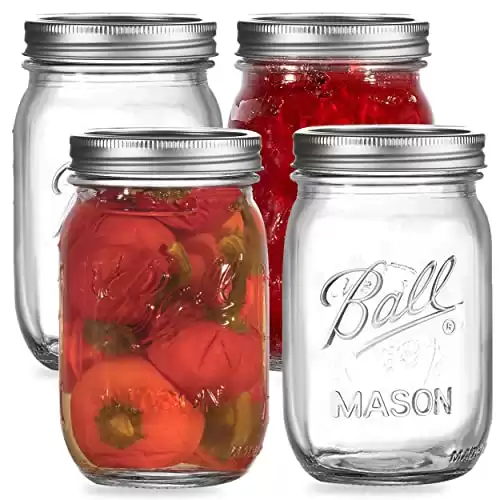
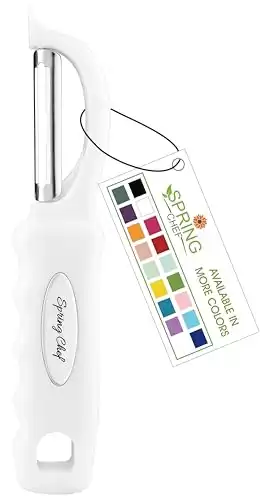
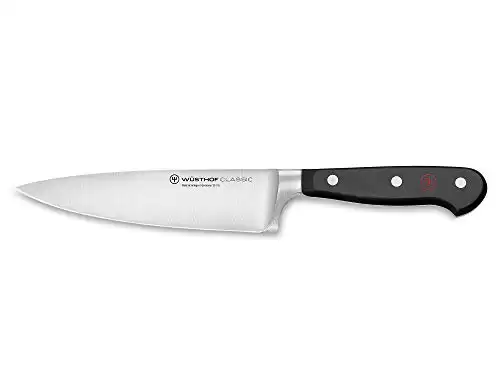
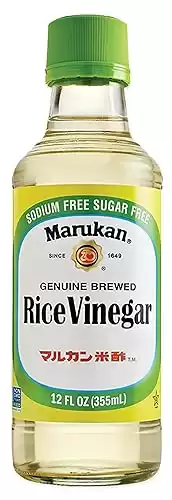
Riley says
This was really easy to make. I got burdock root in my CSA box & had no idea what to do with it. Google & this recipe saved the day.
Angela says
I love that about CSA boxes, it gets you out of your comfort zone & a chance to try new things. Thanks for the comment - enjoy!